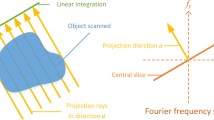Abstract
Inspired by total variation (TV), this paper represents a new iterative algorithm based on diagonal total variation (DTV) to address the computed tomography image reconstruction problem. To improve the quality of a reconstructed image, we used DTV to sparsely represent images when iterative convergence of the reconstructed algorithm with TV-constraint had no effect during the reconstruction process. To investigate our proposed algorithm, the numerical and experimental studies were performed, and root-mean-square error (RMSE) and structure similarity (SSIM) were used to evaluate the reconstructed image quality. The results demonstrated that the proposed method could effectively reduce noise, suppress artifacts, and reconstruct high-quality image from incomplete projection data.










Similar content being viewed by others
References
E.J. Hall, D.J. Brenner, Cancer risks from diagnostic radiology. Br. J. Radiol. 81(965), 362–378 (2008). https://doi.org/10.1259/bjr/01948454
A. Berrington, M. Mahesh, K.P. Kim et al., Projected cancer risks from computed tomographic scans performed in the United States in 2007. Arch. Intern. Med. 169(20), 2071–2077 (2009). https://doi.org/10.1001/archinternmed.2009.440
J.D. Cameron, One-dimensional tomography: a comparison of Abel, onion-peeling, and filtered backprojection methods. Appl. Opt. 31(8), 1146–1152 (1992). https://doi.org/10.1364/AO.31.001146
R. Gordon, R. Bender, G. Herman, Algebraic reconstruction techniques (ART) for three-dimensional electron microscopy and X-ray photography. J. Theor. Biol. 29(3), 471–481 (1970). https://doi.org/10.1016/0022-5193(70)90109-8
H. Andersen, A. Kak, Simultaneous algebraic reconstruction technique (SART): a superior implementation of the ART algorithm. Ultrason. Imaging 6(1), 81–94 (1984). https://doi.org/10.1177/016173468400600107
D. Donoho, Compressed sensing. IEEE Trans. Inf. Theory 52(4), 1289–1306 (2006). https://doi.org/10.1109/TIT.2006.871582
E.Y. Sidky, X.C. Pan, Image reconstruction in circular cone-beam computed tomography by constrained, total variation minimization. Phys. Med. Biol. 53, 4777–4807 (2008). https://doi.org/10.1088/0031-9155/53/17/021
J. Bian, J. Siewerdsen et al., Evaluation of sparse-view reconstruction from flat-panel-detector cone-beam CT. Phys. Med. Biol. 55(65), 75–99 (2010). https://doi.org/10.1088/0031-9155/55/22/001
H. Yu, G. Wang, A soft-threshold filtering approach for reconstruction from a limited number of projections. Phys. Phys. Med. Biol. 55(13), 3905–3916 (2010). https://doi.org/10.1088/0031-9155/55/13/022
Q. Xu, X. Mou et al., Statistical interior tomography. IEEE Trans. Med. Imaging 30(5), 1116–1128 (2011). https://doi.org/10.1109/TMI.2011.2106161
Y. Liu, J. Ma, Y. Fan, Z. Liang, Adaptive-weighted total variation minimization for sparse data toward low-dose X-ray computed tomography image reconstruction. Phys. Med. Biol. 57(23), 7923–7956 (2012). https://doi.org/10.1088/0031-9155/57/23/7923
Q. Xu, H. Yu, X. Mou, et al., Low-dose X-ray CT reconstruction via dictionary learning. IEEE Trans. Med. Imaging 31(9), 1682–1697 (2012). https://doi.org/10.1109/TMI.2012.2195669
H. Li, X. Chen, Y. Wang, et al., Sparse CT reconstruction based on multi-direction anisotropic total variation (MDATV). BioMed. Eng. Online 13, 92 (2014). https://doi.org/10.1186/1475-925X-13-92
T. Goldstein, S. Osher, The split Bregman method for L1-regularized problems. SIAM J Imaging Sci. 2, 323–343 (2009). https://doi.org/10.1137/080725891
M.Y. Chen, D.L. Mi, P. He, et al., A CT reconstruction algorithm based on L1/2 regularization. Comput. Math. Methods Med. (2014). https://doi.org/10.1155/2014/862910
L.Z. Deng, P. Feng, M.Y. Chen, et al., A CT reconstruction algorithm based on non-aliasing contourlet transform and compressive sensing. Comput. Math. Methods Med. (2014). https://doi.org/10.1155/2014/753615
L.Z. Deng, D.L. Mi, P. He, et al., A CT reconstruction approach from sparse projection with adaptive-weighted diagonal total-variation in biomedical application. Bio-Med. Mater. Eng. 26, 1685–1693 (2015). https://doi.org/10.3233/BME-151468
M.Y. Chen, Y. Ren, P. Feng, et al., Computed tomography image reconstruction from few-views data by multi-directional total variation. J. Med. Imaging Health Inf. 5, 309–316 (2015). https://doi.org/10.1166/jmihi.2015.1392
L.Z. Deng, P. Feng, M.Y. Chen, et al., An improved total variation minimization method using prior images and split-Bregman method in CT reconstruction. Biomed. Res. Int. (2016). https://doi.org/10.1155/2016/3094698
H. Zhou, P. Wang, A simpler explicit iterative algorithm for a class of variational in equalities in Hilbert spaces. J. Optim. Theory Appl. 161, 716–727 (2014). https://doi.org/10.1007/s10957-013-0470-x
Z. Yu, F. Noo, F. Dennerlein et al., Simulation tools for two dimensional experiments in X-ray computed tomography using the FORBILD head phantom. Phys. Med. Biol. 57, 237–252 (2012). https://doi.org/10.1088/0031-9155/57/13/N237
W. Zhou, C. Alan, R. Hamid, P. Eero, Image quality assessment: from error visibility to structural similarity. IEEE Trans. Image Process. 13, 600–612 (2004). https://doi.org/10.1109/TIP.2003.819861
M.Y. Chen, Y. Xi, W.X. Cong, et al., X-ray CT geometrical calibration via locally linear embedding. J. X-ray Sci. Technol. 24, 241–256 (2016). https://doi.org/10.3233/XST-160548
Author information
Authors and Affiliations
Corresponding authors
Additional information
This work was supported in part by the National Natural Science Foundation of China (No. 61401049), the Chongqing Foundation and Frontier Research Project (Nos. cstc2016jcyjA0473, cstc2013jcyjA0763), the Graduate Scientific Research and Innovation Foundation of Chongqing, China (No. CYB16044), the Strategic Industry Key Generic Technology Innovation Project of Chongqing (No. cstc2015zdcy-ztzxX0002), China Scholarship Council, and the Fundamental Research Funds for the Central Universities Nos. CDJZR14125501, 106112016CDJXY120003, 10611CDJXZ238826.
Rights and permissions
About this article
Cite this article
Deng, LZ., He, P., Jiang, SH. et al. Hybrid reconstruction algorithm for computed tomography based on diagonal total variation. NUCL SCI TECH 29, 45 (2018). https://doi.org/10.1007/s41365-018-0376-2
Received:
Revised:
Accepted:
Published:
DOI: https://doi.org/10.1007/s41365-018-0376-2




